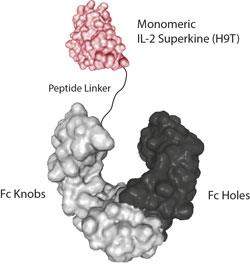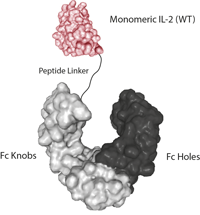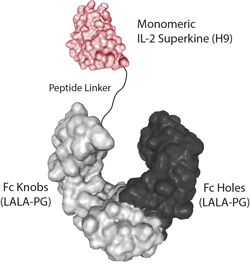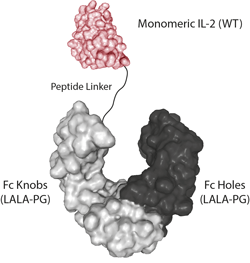IL-2 (mouse):Fc (mouse) (rec.) (non-lytic)
CHI-MF-12002
Product group Proteins / Signaling Molecules
Overview
- SupplierChimerigen Laboratories
- Product NameIL-2 (mouse):Fc (mouse) (rec.) (non-lytic)
- Delivery Days Customer10
- CertificationResearch Use Only
- Estimated Purity>98%
- Scientific DescriptionInterleukin-2 (IL-2) is a 133 amino acid glycoprotein with one intramolecular disulfide bond and variable glycosylation. It is secreted by activated T cells and induces proliferation and maturation of activated T cells, natural killer cells, and lymphokine activated killer cells. IL-2 also stimulates proliferation of antibody-producing B cells, activates neutrophils, and induces mononuclear cells to secrete IFN-gamma and TNF-alpha and -beta. Moreover, studies have shown that IL-2 is required for activation-induced apoptosis, an important hemeostatic mechanism in the immune system, which is involved in the maintenance of peripheral tolerance to self-antigens. - Protein. The extracellular domain of mouse IL-2 (aa 21-169) is fused to the N-terminus of the Fc region of a mutant mouse IgG2a. Source: NS1 cells. Endotoxin content: 98% (SDS-PAGE). Interleukin-2 (IL-2) is a 133 amino acid glycoprotein with one intramolecular disulfide bond and variable glycosylation. It is secreted by activated T cells and induces proliferation and maturation of activated T cells, natural killer cells, and lymphokine activated killer cells. IL-2 also stimulates proliferation of antibody-producing B cells, activates neutrophils, and induces mononuclear cells to secrete IFN-gamma and TNF-alpha and -beta. Moreover, studies have shown that IL-2 is required for activation-induced apoptosis, an important hemeostatic mechanism in the immune system, which is involved in the maintenance of peripheral tolerance to self-antigens.
- Storage Instruction-20°C,2°C to 8°C
- UNSPSC12352202

![IL-2 Superkine (Fc) [IL-2 (human):Fc (human) (rec.)]](https://adipogen.com/pub/media/catalog/product/a/g/ag-40b-0111-superkine_elisa-new.jpg)




